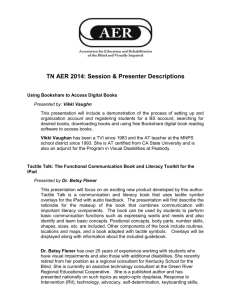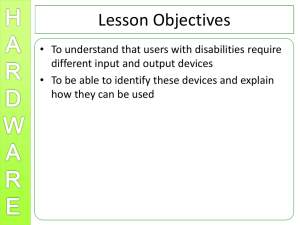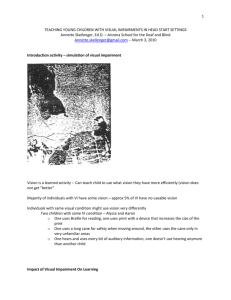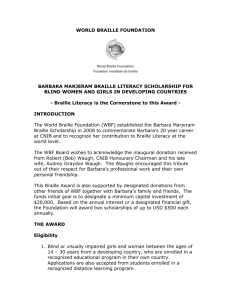Changes in Low Vision Population in the 1960s
advertisement
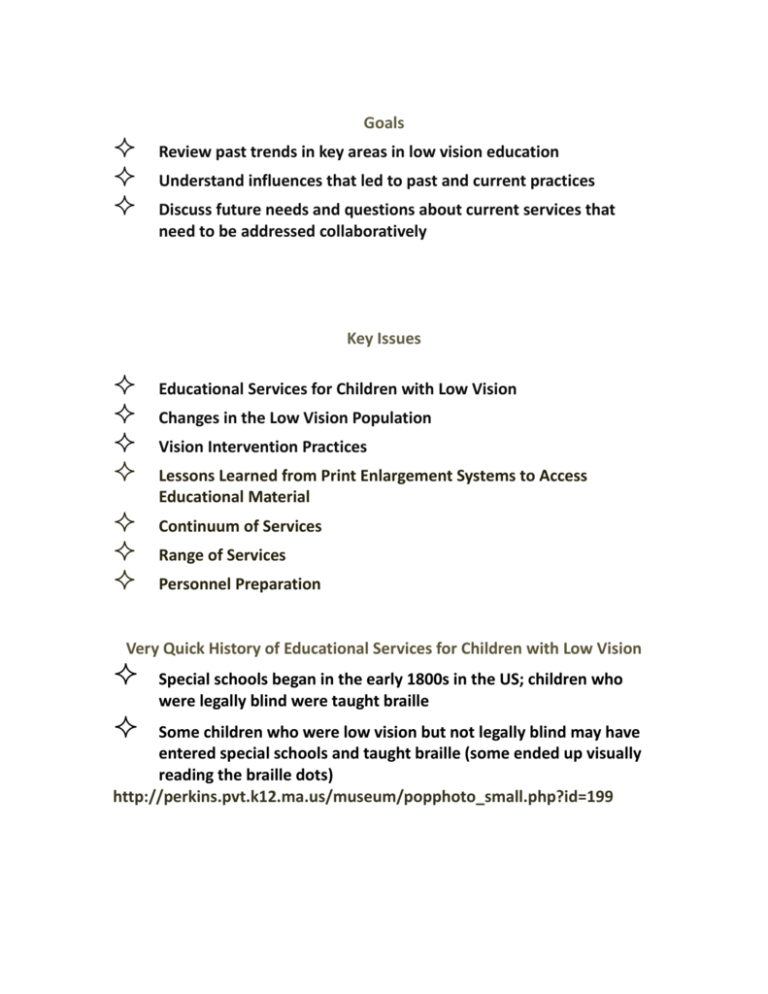
Goals Review past trends in key areas in low vision education Understand influences that led to past and current practices Discuss future needs and questions about current services that need to be addressed collaboratively Key Issues Educational Services for Children with Low Vision Changes in the Low Vision Population Vision Intervention Practices Lessons Learned from Print Enlargement Systems to Access Educational Material Continuum of Services Range of Services Personnel Preparation Very Quick History of Educational Services for Children with Low Vision Special schools began in the early 1800s in the US; children who were legally blind were taught braille Some children who were low vision but not legally blind may have entered special schools and taught braille (some ended up visually reading the braille dots) http://perkins.pvt.k12.ma.us/museum/popphoto_small.php?id=199 Perkins School circa 1830’s “Conservation of Vision” Classes Began around 1913 in the US (later called sight-saving classes) Read large print for short time periods to “conserve” their vision Either segregated classes or integrated for “oral” work with typically sighted peers Classes were for children without additional disabilities Caption: Reading braille with weak eyes causes dangerous eye-strain Students with low vision were 2 to 3 times the number who were blind in Cleveland schools in 1920s – 1 per 1000 pupils. (Irwin, 1920) * . Low Vision Population in Early Sight Conservation Classes in Cleveland Degree of vision of 181 children circa 1920 (Irwin, 1920) Key Developments of 1930’s to Early 1950’s Increased use of large print in 1930s: ophthalmologists no longer thought use of vision would lead to further damage to sight Local school programs increased: influx of children from retrolental fibroplasia (RLF) now called retinopathy of prematurity (ROP) born from the late 1940s to early 1950s Low Vision Services Prior to the mid-1960’s Many children with low vision who were not legally blind and in local school programs received minimal services: large print books and learn typing Children who were legally blind were expected to learn braille and use tactile and auditory learning modes (Hatlen, 2000) Educational Services for Children with Low Vision Techniques developed by the early 1960s were mostly materials and environmental adaptations and included the importance of good lighting * H In 1950’s, suggested definition of children with partial sight for educational services 20/70 or less in better eye with all necessary medical and surgical treatment plus necessary lenses. Must have a residue of sight Visual deviation from normal, who, in the opinion of eye specialist, can benefit from the special educational facilities provided for the partially seeing Undergone eye operations, especially enucleation of an eye and need re-adaptation in use and psychological adjustments Muscle anomalies, especially strabismus, in cases in which re-education of the deviating eye and psychological adjustments are necessary (Hathaway et al, 1959) Hathaway goes on to say: Legal definition of blindness in the US is “not a useful definition of blindness from the educational viewpoint” and many children who are legally blind should be identified as partially seeing (Hathaway, 1959 p.17) Consider special needs of each child Determine educational procedures by medical advisers in cooperation with educational authorities More Changes in Low Vision Population in the 1960s In the 1960s there was another epidemic –congenital rubella syndrome Increase in number of deaf blind who had multiple disabilities in the schools Education systems had to adjust over the years to accommodate this “new” population of children Change Takes Time Even into the 1960s many teachers believed use of vision for near tasks would damage eyes (Hatlen, 2000) Natalie Barraga’s landmark work on vision utilization in 1964 changed everything… Quick History Of Vision Intervention Conservation of vision until 1930’s (and later) Provision of enlarged materials was predominant practice as local programs grew Other interventions were known (e.g., listening skills instruction, handwriting instruction) but often minimally provided in local school programs Major shift in mid-1960’s to direct instruction in vision use along with optical and electronic devices. More on technology later. Current Vision Intervention Techniques: It’s More than Large Print Adapted materials Assistive devices Use of other senses Integrate vision with other senses Instruction in use of vision Instruction in Vision Use Vision stimulation was the predominant trend to encourage use of vision up until the late 1980’s (and perhaps beyond) Fuzzy term that often meant presentation of high intensity visual targets to stimulate or improve sight (Bell, 1986) Assumption is that high intensity stimuli would be reinforcing. It can be if done thoughtfully and with a purpose. Instruction in Vision Use is Now Thought to be More Complex From isolated, direct instruction of a vision skill To infusion of vision skill instruction into functional tasks Instruction in Vision Use Currently: Sensory Rooms – dark rooms with lights, color to stimulate sight in children with visual impairments In current sensory rooms, activities might be facilitated by a teacher to promote specific visual skills or promote next step in a developmental progression http://sensoryequipment.wordpress.com/category/sensory-rooms-forchildren/ Print Enlargement Systems to Access Educational Material Print Size Robert Irwin, who started “conservation of vision” classes in the US, also introduced 36 point type in Clearface font around 1913 This Clearface type proved too large for most students Further studies from 1919 to 1920 by Irwin found that Caslon Bold 24 point type was the most effective print for the production of the Cleartype Series books Print Size (cont’d) Offset lithography (using photographic enlargement) allowed greater ability to adjust print sizes in the 1940s. (Cleartype books were typeset.) Print size recommendations have varied from 14 to 24 point by various agencies. Print Size Today Standard school textbooks in primary grades are 16 to 18 point and sometimes 20 point Textbooks in later grades are 10 to 14 point Large print textbooks in California from K to 8th grade are required to have a minimum print size of 20 point. American Printing House for the Blind’s usual font size is 18 point No Longer “One Size Fits All” With the advent of e-readers and digital textbooks, print size and other print features can be adjusted to meet individual needs Print size can be determined systematically for individual students for typical literacy tasks Optical Devices Anne Corn (2000) spearheaded a movement to raise people’s awareness of the drawbacks on reliance on large print and advantages of optical devices in the schools Portable Relatively inexpensive Allow ready access to material Improved reading performance Children with low vision were not and probably still are not regularly and systematically provided with optical devices and, most importantly, optical device training Optical Device Applications Uses for optical devices have likely changed now that there are ebooks and portable electronic devices that can take over optical device functions But optical devices are still less expensive, less prone to breakdowns and still have a major role for specific visual tasks Closed Circuit Television Systems First model developed by Sam Genensky in 1969 Supplanted optical device use and, in some cases, large print Allowed very high levels of magnification Equipment evolved over time, including the major addition of highly portable electronic devices including e-tablets CCTV Affects Teaching of Braille Literacy Skills Into the early 1990s, some children with very low vision were using extremely high levels of magnification to read Seeing a few letters at a time on the CCTV screen Reading was slow and laborious Many TVIs were not teaching braille which would be a more efficient literacy medium these children Call for increased teaching of braille literacy in the schools by consumer organizations Swing in the Pendulum by Early 1990’s Earlier in the 20th century, children with sufficient vision to read print were taught to read using braille Late in the 20th century, children who could not read print efficiently and who needed to learn braille were not braille literate As a result of these past practices, there is a great emphasis on choosing the most appropriate literacy medium or media, from the results of *functional vision assessment *learning media assessment Lessons Learned: Technology Can Drive Practice Field must keep up with technology Set standards for use of various technologies Adjust standards as needed Provide preparation of personnel to handle the innovations and modified standards using evidence-based practices Overcome inertia where field wants to stay the same Temper enthusiasm where quick adoption of technology or methods supplants careful educational assessment and planning Not discontinue past methods that may still play a role in literacy Who Are the Children with Low Vision? Recent years - increase in children with visual impairments, many with multiple disabilities due to improved care of very low birth weight premature infants improved medical care of newborns with life-threatening conditions Majority of students in schools are low vision and most children in the schools have multiple disabilities – 85% (Kirchner & Diamont, 1999 per Lueck) Damage to the Visual Brain CVI is now the major cause of visual impairment in children in the US Hard to estimate numbers Children with traditional hallmarks of VI measured by acuity and field loss. Many children with additional disabilities have undiagnosed CVI Children with near-normal acuity but visual processing disorders. Many of these children are undiagnosed and not receiving services. Low Vision Population Changes have Led to Changes in the Educational System Over Time Over time, educational system needed to adjust to meet the needs of influx of children due to RLF (ROP) Congenital Rubella Life-preserving medical procedures • • CVI Children with multiple disabilities Latest Adjustments to Changing Population of Low Vision Children Revisiting of definition of students with visual impairments Development of appropriate assessment and intervention techniques New information for personnel prep programs Additional training of veteran teachers Inclusion of other personnel in educational teams May require re-thinking of some current systems and personnel responsibilities Questions about what professional specialties should serve children with normal/near normal vision but who have damage to the visual brain Appropriate school environments for children enfolded into Universal Design for all students Appropriate school placements Range of Services: It’s More Than Large Print Access to core curriculum Expanded core curriculum Compensatory and Functional Academic Skills including communication modes Orientation and Mobility Skills Social Interaction Skills Independent Living Skills Recreation and Leisure Skills Career Education Assistive Technology Self-Determination Sensory Efficiency Skills Range of Services: It’s More Than Large Print Emphasize service needs in low vision for Early intervention Transition after high school Instruction for students who have multiple disabilities Continuum of Services Today from full inclusion to special schools: Full inclusion in regular education • Accommodations under Section 504 of Rehabilitation Act of 1973, or • Services of TVI Special resource room part of day (TVI) Full day resource room for VI Special day class for additional disability with TVI services Special school for VI Types of Teaching Assignments Tied to Continuum of Services Consultant service (TVI) Itinerant teacher service by teacher of visually impaired (TVI) Resource room teacher Special day class teacher Teacher in special school for VI Types of Services Available & Students’ Access to Appropriate Services Affected by: Funding and staff availability Changes in what children need due to • • Changes in population Exponential growth of knowledge Changing emphases in general education Current Dilemma in VI Education There is so much more to be taught Decrease in services due to funding along with shortage of qualified TVIs and O&M specialists Increased use of consultation services, This has led to • • • Increased case loads Many in the field of visual impairments are concerned that the range of services are not being provided in the core and expanded core curricula How to provide services to the population of children with CVI with resources so tight Some Solutions Methods to increase services: para-educators, interveners for deafblind. Is this enough? Should there be more teaming by educators with interventionists from other educational area and medical teams for children with vision loss due to brain injury? Collaborative solutions Personnel Preparation Address the expansion of knowledge and changes in population served in pre-service programs Continuing education needs for veteran teachers Collaborative training needs with other fields Summary: Complex Interplay of Factors Affect Service Provision Aside from funding issues, changes in low vision services in schools have been affected by changes in: • • • • • Overall climate of general and special education Populations of children who have low vision Technological advances and accessibility Medical philosophies and developments Definition of low vision • Education background and philosophy of service providers Future Directions in The Education of Children Who Have Low Vision: A Few Questions * * * * * * Should the VI education field consider the development of subspecializations: technology, low vision, braille literacy, early childhood, children with VI & multiple disabilities, CVI? Is there a need to again clarify the definition of children served by teachers of the visually impaired and O&M specialists with the changing low vision population? Should educators collaborate more closely in planning services for children with low vision with the medical community including occupational therapists in order to provide the full range of service needs to the increasingly complex pediatric low vision population? Thank you! Selected References Ayer, S. (1998). Use of multi-sensory rooms for children with profound and multiple learning disabilities. Journal of Intellectual Disabilities, 2,(2) 89-97. Bell, J. (1986). An approach to the stimulation of vision in the profoundly handicapped visually handicapped child. British Journal of Visual Impairment, 4, 46-48. Corn, A., Wall, R., & Bell, J. (2002). Impact of optical devices on reading rates and expecttions for school-age children and youth with low vision. Visual Impairment Research, 2000, 2(1), 33-41 Goetz, L. & Gee, L. (1987) Functional vision programming: A model for teaching visual behavior in natural contexts. In L. Goetz, D. Guess, & K. Stremmel-Campbell (eds.) Innovative program design for individuals with dual sensory impairments: Paul Brookes Goetz,L. & Gee, K. (1987) Teaching visual attention in functional contexts: Acquisition and generalization of complex motor skills. Journal of Visual Impairment & Blindness, 81, 115-117. Hathaway, W., Foote, F.F., Bryan, D., Gibbons, H. (1959). Education * * * * * * and health of the partially seeing child. New York: Columbia University Press for National Society for the Prevention of Blindness. Hatlen, P. (2000). Historical perspectives in Holbrook, M.C., & Koenig, A.J. (Eds.) Foundations of education Volume 1.History and theory of teaching children with visual impairments. NY: AFB Press. pp.1-54 Hatlen, P. (2000). Historical perspectives in Holbrook, M.C., & Koenig, A.J. (Eds.) Foundations of education Volume 1.History and theory of teaching children with visual impairments. NY: AFB Press. pp.1-54 Irwin, R.B. (1920) Sight-saving classes in the public schools. Harvard University, Cambridge. Kirchner, C., & Diamant, S. (1999) Estimate of number of visually impaired students, their teachers, and orientation and mobility specialists: Part 1. Journal of Visual Impairment & Blindness. 93, 600606. Kitchel, E., (2004). Large Print: Guidelines for Optimal Readability and APHontTM a font for low vision. http://www.aph.org/edresearch/lpguide.htm retrieved April 3, 2006. Lundervald, D., Lewin, L., & Irvin, L. (1987) Rehabilitation of visual impairments: A crticial review. Clinical Psychology Review, 7, 169-185
